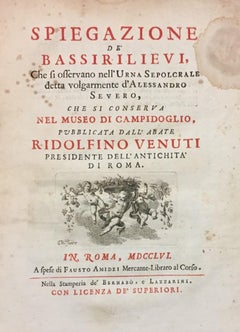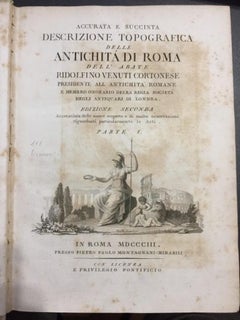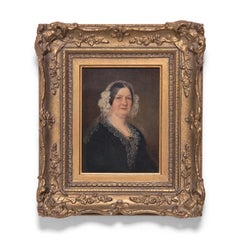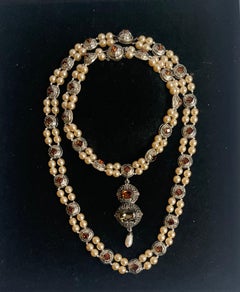Ridolfino Venuti Art
to
2
1
1
1
1
1
1
1
Spiegazione de' bassirilievi dell'urna detta d'Alessandro Severo - 1756
By Ridolfino Venuti
Located in Roma, IT
Cover on cardboard and decorated in quite good conditions. Lightly damaged on spine. Inside quite good conditions except foxing on right side of some pages. quite fresh prints. Inclu...
Category
1750s Modern Ridolfino Venuti Art
Materials
Paper
Accurata e succinta descrizione topografia delle Antichità di Roma
By Ridolfino Venuti
Located in Roma, IT
Complete title: Accurata e succinta descrizione topografia delle Antichità di Roma dell'Abate Ridolfino Venuti Cortonese Presidente all'Antichità Romane e Membro Onorario della Regia...
Category
Early 1800s Old Masters Ridolfino Venuti Art
Materials
Paper, Etching
Related Items
Oil Portrait of a Victorian Lady, c. 1850
Located in Chicago, IL
Painted in the 19th century, this exquisite miniature portrait wonderfully exemplifies realism in traditional oil painting. The small artwork is painted in the conventional portraiture style of the Old Masters, and achieves soft realism with fine brushwork and a subdued, neutral palette. The half length portrait depicts a fine Victorian woman dressed in all black with a delicate lace collar and bonnet. She wears a ruby broach...
Category
Mid-19th Century Old Masters Ridolfino Venuti Art
Materials
Oil
The Necklace of Jane Seymour, Henry VIII's Third Wife, Limited Edition, Signed
By Hiroshi Sugimoto
Located in New York, NY
Hiroshi Sugimoto
The Necklace of Jane Seymour, Henry VIII's Third Wife, 2000
Limited Edition Signed pendant of silver-plated brass, imitation pearls, Swarovski glass stones, handmade...
Category
16th Century Old Masters Ridolfino Venuti Art
Materials
Metal
Portrait of a Gentleman, David Erskine, 13th Laird of Dun, Wearing Armour c.1700
Located in London, GB
The gentleman in this exquisite oil on canvas portrait, presented by Titan Fine Art, is shown with the grandiloquence characteristic of the English School of painting. He is portray...
Category
17th Century Old Masters Ridolfino Venuti Art
Materials
Oil, Canvas
$7,981
H 35.44 in W 30.71 in D 2.37 in
Portrait of lady, Mary Hammond in Rich Attire, Jewels, Lace c.1618-22 Historical
By Cornelius Johnson
Located in London, GB
Portrait of Mary Hammond in Sumptuous Attire, Jewels and Lace c.1618-22
Circle of Cornelius Johnson (1593-1661)
This portrait of a lady, presented by Titan Fine Art, is an exquisite...
Category
17th Century Old Masters Ridolfino Venuti Art
Materials
Oil, Panel
$19,262
H 33.47 in W 27.17 in D 2.37 in
Dutch Old Master Portrait of Maurits, Prince of Orange-Nassau, Oil on Panel
Located in London, GB
In 1607, the Delft city council decided to commission a portrait of Stadholder Maurits of Nassau for the town hall, with Michiel van Mierevelt as the chosen artist due to the passing...
Category
17th Century Old Masters Ridolfino Venuti Art
Materials
Oil, Wood Panel
$11,603
H 37.8 in W 33.47 in D 2.37 in
English Modern Geometric Collage Purple, Gold, and Beige
Located in Houston, TX
Abstract modern collage of long geometric shapes in blue, brown, and beige, by artist Spe, 2000's . Signed. Displayed in a white mat with a gold border and fits a standard-size frame...
Category
Early 2000s Modern Ridolfino Venuti Art
Materials
Paper
Portrait of Lady, Barbara Herbert, Countess of Pembroke c.1708, Large Painting
Located in London, GB
Portrait of Barbara Herbert, Countess of Pembroke c.1708
Charles d’Agar (1669-1723)
This magnificent large-scale portrait, presented by Titan Fine Art, depicts the British court of...
Category
17th Century Old Masters Ridolfino Venuti Art
Materials
Cotton Canvas, Oil
$17,237
H 49.61 in W 46.86 in D 2.76 in
Portrait of a Lady, Mrs Wray in a Silk Dress & Pink Wrap c.1698, Oil on canvas
By Michael Dahl
Located in London, GB
Portrait of a Lady, Mrs Wray in a Silk Dress & Pink Wrap c.1698
Circle of Michael Dahl (1659-1743)
This delightful work, presented by Titan Fine Art, is a fine example of British po...
Category
17th Century Old Masters Ridolfino Venuti Art
Materials
Cotton Canvas, Oil
$14,017
H 34.65 in W 29.93 in D 2.37 in
Portrait of a Gentleman, Doublet & White Ruff, Gloves Inscribed 1624, on panel
By Frans Pourbus the Younger
Located in London, GB
Titan Fine Art presents this exquisite oil on panel portrait depicting a handsome young gentleman in an exuberant black damask doublet. The pose, with one hand holding gloves and the other akimbo, was one that was well-established for gentleman of the upper echelons of society by the time this work was painted. The principle governing portraits at this time was the recording and defining in visual terms of the position of a sitter in society. In addition to brilliant and complex symbols of luxury, they often contained many symbolic elements too; the inclusion of gloves was often used in portraits that celebrated a betrothal as in ancient times gloves were used to seal a marriage contract.
The extraordinary costume of a black shimmering doublet, the brilliant white reticella ruff, and the cuffs edged with lace were immensely costly… this attire proclaims to every onlooker that this is a superior being. The rendering of the reticella lace ruff is exquisite and the artist has recorded the design that runs through the black damask fabric with meticulous attention to detail. The preservation of this black pigment is remarkable considering the age of the work. Black pigments are especially vulnerable to fade and wear over time partly due to environmental condition but also from unprofessional cleaning. This work is an exquisite example from the period.
According to the inscription in the upper right, the gentleman was in his 22nd year of age in 1624. The coat of arms, which is displayed without a crest, may be ‘blazoned’ in the language of heraldry, as: Sable on a Chevron between in chief two Roundels and in base a Billet [or possibly Square] Or three Martlets Sable. In plainer English this means a black (Sable) background, spanned by a gold (Or) chevron, above which are two golden solid circles (Roundels), and below which is a gold rectangle (Billet); on the chevron are three small black birds (Martlets). Martlets are a stylised form of heraldic bird, believed to be based on the swift, which are conventionally drawn with small tufts instead of feet. In Continental Europe it is also conventional for them to be drawn without beaks, as appears to be the case here. The birds in this instance also have a vaguely duck-like appearance.
Five families have been identified with very close armorial bearings to the one in our portrait. They are the (van) Houthem’s (of Brabant), the Prévinaire’s (of Flanders and Holland), and the Proveneer’s (of Liège) and it must be noted that the locations of these families also fit with the painting’s Flemish origins. However the French Grenières’s (of Île-de-France) and the Jallot’s (of Normandy) are the next closest matches and plausible matches, as Frans Pourbus had settled in Paris just a few years before our portrait was painted.
This painting has been assessed by a professional conservator prior to going on sale, and as thus, it can be hung and enjoyed immediately.
Frans Pourbus the Younger...
Category
17th Century Old Masters Ridolfino Venuti Art
Materials
Oil, Wood Panel
$17,919
H 42.13 in W 31.11 in D 3.94 in
Portrait Gentleman Armour, Blue Cloak, Diamond Brooch c.1700 French Carved Frame
By Joseph Vivien
Located in London, GB
Portrait of a Gentleman in Armour and Azure Cloak with Diamond Brooch c.1700
Attributed to Joseph Vivienne (1657-1735)
The sitter in this superb portrait, offered by Titan Fine Art...
Category
17th Century Old Masters Ridolfino Venuti Art
Materials
Oil, Cotton Canvas
$18,042
H 35.83 in W 29.93 in D 3.15 in
Seventeenth Century Old Master Biblical Oil Painting Joseph recounts his Dream
By Rembrandt van Rijn
Located in ludlow, GB
Seventeenth Century Old Master Biblical themed Oil Painting on Panel of Joseph recounting his Dream. A Follower of Rembrandt Harmensz Van Rijn 1606 - 1669. This painting follows a ...
Category
17th Century Old Masters Ridolfino Venuti Art
Materials
Oil
$16,097
H 22 in W 19 in D 1 in
Portrait of a Gentleman in Grey Coat & White Cravat, Oil on canvas Painting
Located in London, GB
This exquisite work, presented by Titan Fine Art, is by the notable artist Hans Hysing, who was a noteworthy painter in England; it is significant in its q...
Category
18th Century Old Masters Ridolfino Venuti Art
Materials
Canvas, Oil
$9,725
H 36.62 in W 31.5 in D 1.97 in
Ridolfino Venuti art for sale on 1stDibs.
Find a wide variety of authentic Ridolfino Venuti art available for sale on 1stDibs. You can also browse by medium to find art by Ridolfino Venuti in paper, etching and more. Much of the original work by this artist or collective was created during the 18th century and is mostly associated with the Old Masters style. Not every interior allows for large Ridolfino Venuti art, so small editions measuring 8 inches across are available. Customers who are interested in this artist might also find the work of William Blake, Studio of Sir Peter Lely, and Yann Barrerre. Ridolfino Venuti art prices can differ depending upon medium, time period and other attributes. On 1stDibs, the price for these items starts at $668 and tops out at $9,358, while the average work can sell for $5,013.



